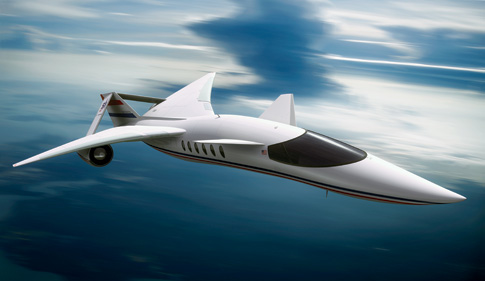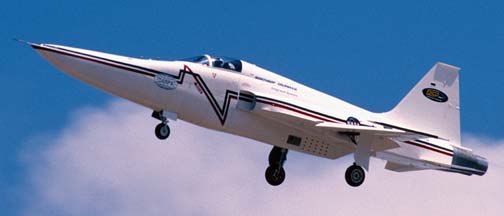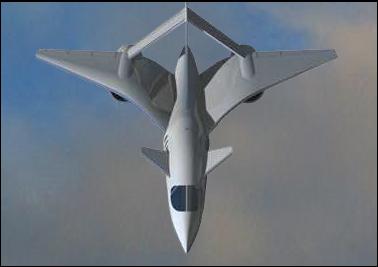A new age for air travel is dawning; at least if you’re one of the lucky few in the market for supersonic luxury travel. Lockheed Martin's advanced Skunk Works unit is designing a small, 12-seat passenger jet that would travel at 1,200 mph (Mach 1.8) but which would produce only a whisper of the annoying crack once emitted by the retired Concorde.
Aimed at business executives and diplomats, the QSST will fly at nearly twice the speed of conventional business jets and have a range of 4,600 miles nonstop -- Los Angeles to New York in just over two hours. The sleek, 130-foot-long QSST (for "quiet supersonic transport") aircraft is being designed for a Nevada consortium called Supersonic Aerospace International, or SAI, at an estimated cost of $2.5 billion. According to the company, it could be ready for boarding by 2013.

It seems that this is a technology that is long overdue, and it may seem curious that domestic supersonic travel doesn’t already exist. But it’s been the pesky sonic boom that accompanies supersonic flight that has prevented development in this area -- until now.
Because of the excessive noise disruption that a sonic boom causes to the population below a plane’s flight path, supersonic flight is currently banned over land. This is why the recently retired Concorde was limited only to transatlantic flights. However, the QSST boasts a patented design that produces a low “shaped sonic signature” that is over 100 times quieter than the Concorde.
To develop the technology required to “quiet” a sonic boom, it’s important to understand the forces that create it in the first place. When an object passes through the air, it creates a series of pressure waves in front of it and behind it, similar to the bow and stern waves created by a boat. These waves travel at the speed of sound, and as the speed of the object increases, the waves are forced together, or compressed, because they cannot "get out of the way" of each other, eventually merging into a single shock wave at the speed of sound. This critical speed is known as Mach 1 and is approximately 1,225 kilometers per hour (761 mph) at sea level.
The Formation of a "Sonic Boom"
The following graphics do a fantastic job of illustrating the phenomenon of sound waves, and their creation of the intense pressure waves that produce sonic booms. All animations and accompanied descriptions are courtesy of Dr. Dan Russell, Kettering University.
Stationary Sound Source

This illustration shows a stationary sound source. Sound waves are produced at a constant frequency, and the wave fronts propagate symmetrically away from the source at a constant speed, which is the speed of sound in the medium. The distance between wave fronts is the wavelength. All observers will hear the same frequency, which will be equal to the actual frequency of the source.
Source moving Slower than the Speed of Sound

This shows the same sound source radiating sound waves at a constant frequency in the same medium, however now the sound source is moving to the right. The wave fronts are produced with the same frequency as before. However, since the source is moving, the center of each new wave front is now slightly displaced to the right. As a result, the wave fronts begin to bunch up on the right side (in front of) and spread further apart on the left side (behind) of the source. An observer in front of the source will hear a higher frequency, and an observer behind the source will hear a lower frequency.
Source moving Equal To the Speed of Sound

Now the source is moving at the speed of sound in the medium (Mach 1). The wave fronts in front of the source are now all bunched up at the same point. As a result, an observer in front of the source will detect nothing until the source arrives. The pressure front will be quite intense (a shock wave), due to all the wave fronts adding together, and will not be perceived as a pitch but as a "thump" of sound as the pressure wall passes by.
Source moving Faster Than the Speed of Sound

The sound source has now broken through the sound speed barrier, and is traveling at faster than the speed of sound. Since the source is moving faster than the sound waves it creates, it actually leads the advancing wave front. The sound source will pass by a stationary observer before the observer actually hears the sound it creates.
Notice the clear formation of the Mach cone, the angle of which depends on the ratio of source speed to sound speed. It is this intense pressure front on the Mach cone that causes the shock wave known as a sonic boom as a supersonic aircraft passes overhead. The shock wave advances at the speed of sound, and since it is built up from all of the combined wave fronts, the sound heard by an observer will be quite intense. A supersonic aircraft usually produces two sonic booms, one from the aircraft's nose and the other from its tail, resulting in a double thump.
Shaped Sonic Boom Demonstration
There is no escaping the creation of a sonic boom once the sound barrier is broken, but a great deal of study has been going into lessening its effects. In 2003, researchers successfully reduced the sonic booms produced by a U.S. Navy jet by giving it a nose job. Under the Shaped Sonic Boom Demonstration (SSBD) program sponsored by Defense Advanced Research Projects Agency (DARPA), NASA and Northrop Grumman -- researchers tacked on custom nose-glove to the front of Navy F-5E jet, as well as added an aluminum substructure.

Since the culprit in the creation of a sonic boom is a change in air pressure, the approach of sonic boom reduction focused on altering how this pressure change is distributed. The added volume on the modified F-5E allowed researchers to better distribute the air pressure build-up in front of the supersonic plane, which shaped how the pressure was later released in a sonic boom shockwave as the aircraft broke the sound barrier. Modifying that pressure release resulted in softer sonic booms. The modifications eliminated about a third of the pressure typically released by unmodified supersonic aircraft, a noticeable difference when the F-5E boom was followed 45 seconds later by one from an unmodified aircraft.

The Aerodynamics of the QSST
In addition to using innovative aerodynamic shaping, the QSST employs a patented, inverted "V-tail" - instrumental in the radical reduction of QSST’s sonic sound level. These design elements are covered by 22 patent applications that are instrumental in the significant reduction of QSST’s sonic signature. Only QSST will fly at twice the speed of current commercial passenger and business jets using a “shaped sonic signature.”
The QSST uses fine-tuned aerodynamics to control the pressure generated as the plane displaces air at supersonic speeds. With air disturbances along the craft evened out, the QSST generates more shockwaves of smaller magnitude rather than two explosive shockwaves.

To soften the boom, QSST aerodynamicists sought to spread out the pressure points along the fuselage. The new aircraft [above] generates only moderate shocks at the nose [2] and tail [3] with no spike in the middle. The stretched nose creates a small but distinct pressure spike at the front, as does the rear engine placement. These two small spikes counter the tendency of the wave to travel forward and backward. By the time the sound reaches the ground [4], the N-wave has diffused into a barely audible poof. QSST will have 'supercruise’ sound levels that are so low that SAI believes QSST will be capable of receiving governmental approval for supersonic flight over land and populated areas without causing objection from the general public.

Another key to quiet flight is its broad distribution of lift-generating surfaces. The QSST´s canards-the small wings near the front of the fuselage-and swept-V tail provide substantial lift, preventing the sharp, loud-boom-generating pressure change typical of larger, wider wings. The QSST is so sleek that it can fly 10 percent farther on its fuel supply supersonically than it can at subsonic speeds.
The inverted-V tail also allows the two engines to be mounted far aft -- a design feature that further separates the pressure waves and keeps them from crashing into one another. Normally, this engine placement would require extra material to support the cantilevered weight, but the inherent strength of the V tail's truss shape compensates.
All of this technology comes with a nice side of luxury as well. Up to twelve passengers will be able to travel in large cabin comfort. Configured with club chairs, couches, a spacious bathroom and a sweet A/V system, the QSST is aimed at diplomats or executives with plenty of money-but little time-to spare.

I know I personally look forward to the day that I can enjoy a latte at high elevation as I race toward the West Coast in time to view the sunset. After -- of course -- enjoying the earlier showing that same evening on the East Coast.
http://www.saiqsst.com/index.html
http://en.wikipedia.org/wiki/Sonic_boom
http://www.space.com/businesstechnology/technology/sonicboom_techwed_042...
http://www.popsci.com/military-aviation-space/article/2007-03/all-sonic-...




Comments